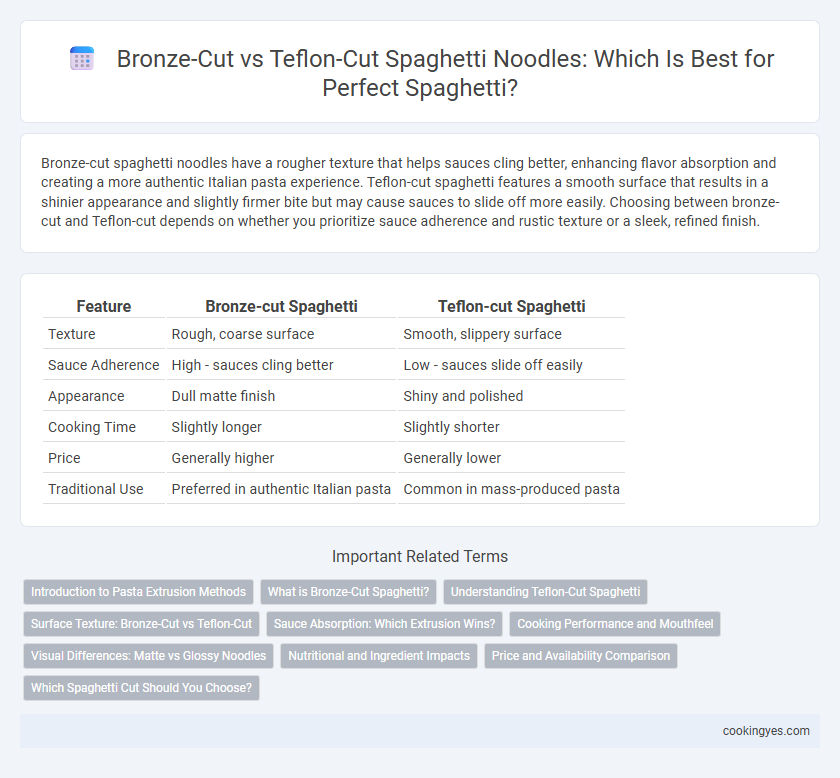Bronze-cut spaghetti noodles have a rougher texture that helps sauces cling better, enhancing flavor absorption and creating a more authentic Italian pasta experience. Teflon-cut spaghetti features a smooth surface that results in a shinier appearance and slightly firmer bite but may cause sauces to slide off more easily. Choosing between bronze-cut and Teflon-cut depends on whether you prioritize sauce adherence and rustic texture or a sleek, refined finish.
Table of Comparison
| Feature | Bronze-cut Spaghetti | Teflon-cut Spaghetti |
|---|---|---|
| Texture | Rough, coarse surface | Smooth, slippery surface |
| Sauce Adherence | High - sauces cling better | Low - sauces slide off easily |
| Appearance | Dull matte finish | Shiny and polished |
| Cooking Time | Slightly longer | Slightly shorter |
| Price | Generally higher | Generally lower |
| Traditional Use | Preferred in authentic Italian pasta | Common in mass-produced pasta |
Introduction to Pasta Extrusion Methods
Bronze-cut spaghetti noodles feature a rougher surface texture created by bronze dies during pasta extrusion, enhancing sauce adhesion and delivering a more authentic Italian dining experience. Teflon-cut noodles use non-stick Teflon dies that produce a smoother surface, resulting in quicker cooking times but less sauce absorption. Selection between bronze-cut and Teflon-cut methods impacts the noodle's texture, cooking behavior, and flavor integration in traditional pasta dishes.
What is Bronze-Cut Spaghetti?
Bronze-cut spaghetti is made by extruding dough through bronze dies, creating a rough and porous surface that better holds onto sauces and enhances flavor absorption. This traditional method contrasts with teflon-cut pasta, which uses smoother non-stick dies resulting in a slicker texture that can cause sauces to slide off. The textured surface of bronze-cut spaghetti is prized for improving sauce adhesion and delivering a more authentic Italian pasta experience.
Understanding Teflon-Cut Spaghetti
Teflon-cut spaghetti noodles are produced using non-stick Teflon-coated dies, which result in a smoother surface texture compared to bronze-cut pasta. This smoother finish prevents sauce from clinging as effectively, making Teflon-cut spaghetti less ideal for thick or chunky sauces. However, Teflon-cut pasta is often more affordable and has a consistent shape, appealing to consumers seeking budget-friendly options.
Surface Texture: Bronze-Cut vs Teflon-Cut
Bronze-cut spaghetti noodles feature a rough, porous surface that effectively holds sauces, enhancing flavor absorption and providing a traditional, artisanal texture preferred by gourmet chefs. In contrast, Teflon-cut noodles have a smooth, polished surface resulting in a slippery texture that causes sauces to slide off, often favored for quicker cooking and a more uniform appearance. This difference in surface texture significantly impacts the overall eating experience and sauce adherence, influencing the choice between bronze-cut and Teflon-cut pasta.
Sauce Absorption: Which Extrusion Wins?
Bronze-cut spaghetti noodles feature a rougher surface texture created by bronze dies, enhancing sauce adhesion and absorption compared to the smooth, non-stick finish of Teflon-cut noodles. This textured surface allows sauces to cling better, resulting in a more flavorful and cohesive dish. Culinary experts often prefer bronze-cut pasta for recipes with rich or chunky sauces due to its superior sauce retention properties.
Cooking Performance and Mouthfeel
Bronze-cut spaghetti noodles have a rougher surface texture, allowing sauces to cling better and enhancing overall flavor absorption during cooking. This texture results in a firmer bite and chewier mouthfeel, preferred in traditional Italian pasta dishes for its authenticity. In contrast, Teflon-cut noodles are smoother and cook more evenly but can feel less textured and may not hold sauces as effectively, leading to a softer, less pronounced chew.
Visual Differences: Matte vs Glossy Noodles
Bronze-cut spaghetti noodles exhibit a matte, rough surface that enhances sauce adhesion by creating a textured exterior, while Teflon-cut noodles are characterized by a smooth and glossy finish that results from the non-stick molds used during production. The bronze-cut method preserves microscopic grooves on the pasta, contributing to its artisanal appearance and improved flavor absorption. In contrast, Teflon-cut spaghetti has a polished, shiny look that reflects light and provides a uniform, sleek aesthetic but less effective sauce clinging.
Nutritional and Ingredient Impacts
Bronze-cut spaghetti noodles have a rougher surface, which enhances sauce adherence and retention of nutrients like protein and fiber due to less processing. Teflon-cut noodles feature a smoother texture from non-stick surfaces that can reduce the retention of beneficial ingredients, potentially leading to a slight loss in nutritional quality. The choice between bronze-cut and Teflon-cut impacts texture and nutrient absorption, with bronze-cut preferred for richer flavor and greater nutrient preservation.
Price and Availability Comparison
Bronze-cut spaghetti noodles typically cost more due to the labor-intensive process and limited production compared to Teflon-cut varieties, which are mass-produced and more widely available in supermarkets. Bronze-cut pasta offers a rougher texture that holds sauce better, often found in specialty stores or premium brands, while Teflon-cut pasta has a smoother surface and is generally sold at lower prices in mainstream grocery outlets. Consumers prioritizing affordability and convenience tend to choose Teflon-cut spaghetti, whereas those seeking artisanal quality are willing to pay higher prices for bronze-cut options.
Which Spaghetti Cut Should You Choose?
Bronze-cut spaghetti has a rough texture that allows sauces to cling better, enhancing flavor absorption and offering an authentic Italian dining experience. Teflon-cut spaghetti, characterized by a smoother surface, cooks faster and provides a firmer bite, making it ideal for lighter sauces. Choosing between bronze-cut and Teflon-cut spaghetti depends on your preference for sauce adherence and texture richness in the final dish.
Bronze-cut vs Teflon-cut for spaghetti noodles Infographic

 cookingyes.com
cookingyes.com